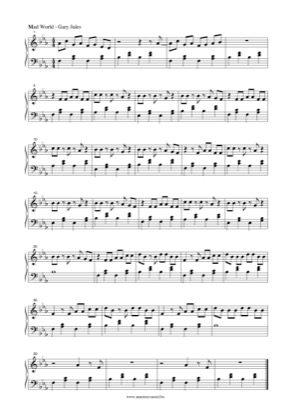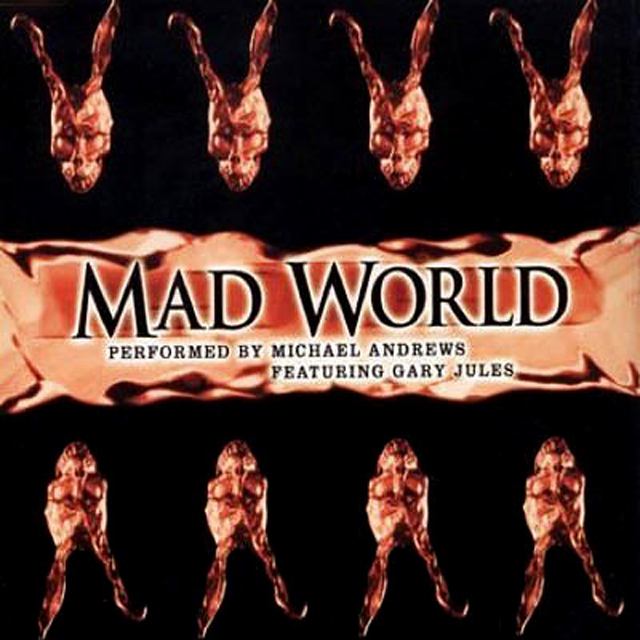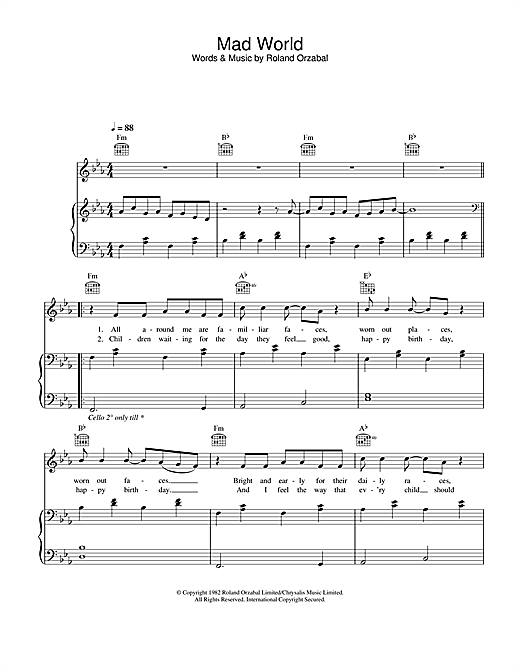
9 Michael Andrews and Gary Jules version.The cover photo was taken at Round Pond in Kensington Gardens (London, England). A 2021 rendition of the song was included on Demi Lovato's album Dancing with the Devil.

"Mad World" has since been covered by various artists, including a 2001 version recorded by Michael Andrews and Gary Jules for the soundtrack of the film Donnie Darko a 2003 single release of the song reached number one in the UK for three consecutive weeks and won Orzabal his second Ivor Novello Award. This single was also the band's first international success, reaching the Top 40 in several countries in 1982–83. Both "Mad World" and its B-side, "Ideas as Opiates", appeared on the band's debut LP The Hurting (1983). Written by Roland Orzabal and sung by bassist Curt Smith, it was the band's third single release and first chart hit, reaching number three on the UK Singles Chart in November 1982. “Tell me what’s my lesson” can also be asked sarcastically, as the narrator can be critiquing the teacher and the school system for not actually teaching children anything useful." Mad World" is a 1982 song by British band Tears for Fears. Thinking about how the unfulfilling cycle will continue is too much to bear, and makes him want to drink until he forgets.Īttending school is just as mundane as adult life- all the children are taught the same lessons, regardless of skill level or interest, and the teacher looks right through the narrator because he’s just one of many interchangeable children, a number instead of an individual. The narrator wants to put his head down and pretend that there’s “no tomorrow”, since each day is the same as the last. No one understood him and he faded into the background. The Narrator was just like these children he describes.

The rest of the year, children are taught to be seen and not heard, following the instructions of those around them and never thinking for themselves, so that they can grow up to fulfill the status quo.

Instead of feeling cherished and alive every day of the year, children spend the year looking forward to the one day they get to feel special- their birthday.

The narrator repeats “kind of” twice, which emphasizes that even these feelings barely register. “Filling up their glasses” is referring to drinking glasses (i.e., each person is extremely sad, and goes through their life drinking bitterness) or eyeglasses (suggesting that the tears waver in their eyes but never fall past the frames). Since everyone is going through life on automatic, trying hard not to think or show how sad they are, everyone thinks everyone else is fine. Their tears are filling up their glassesĪlthough everyone feels like the narrator, sad and unfulfilled, they hold it back so that their sadness doesn’t show.The imagery of a race sums up this unchanging existence, since many races occur on tracks which quite literally “Go nowhere”. The narrator is stuck in a dull routine, seeing the same old people and doing the same old things over and over again.Įach day, everyone wakes up early to get a head start in the rat race, competing for money or power, but because everyone is stuck in the system, no one really gets ahead.


 0 kommentar(er)
0 kommentar(er)
